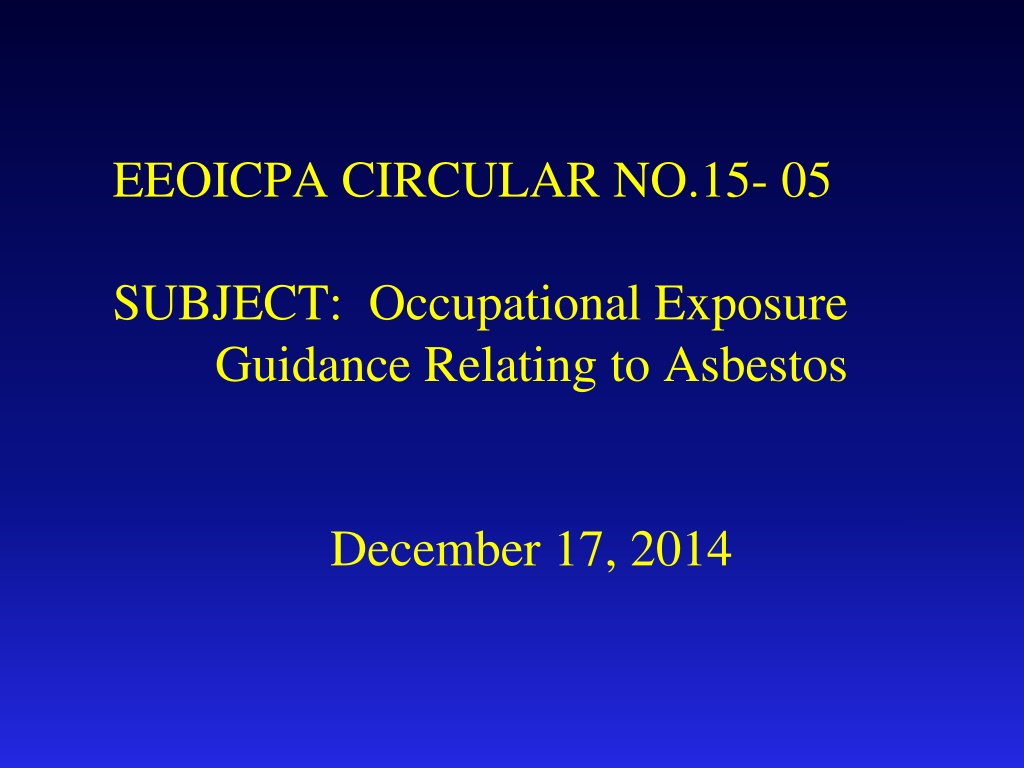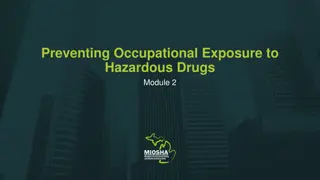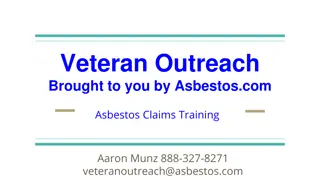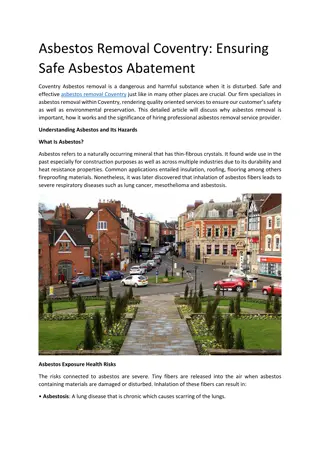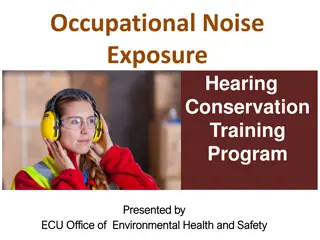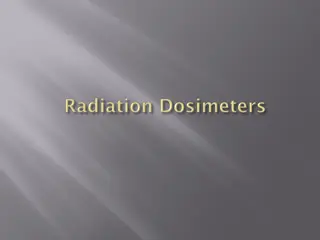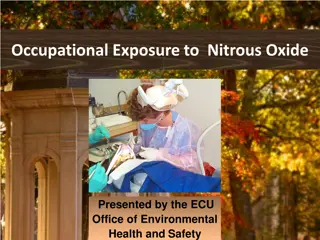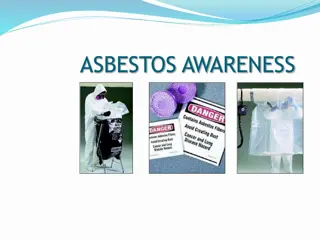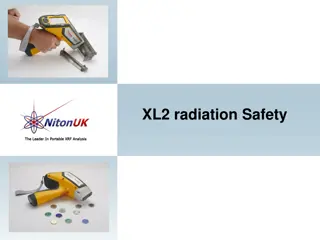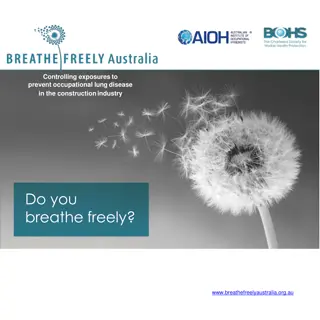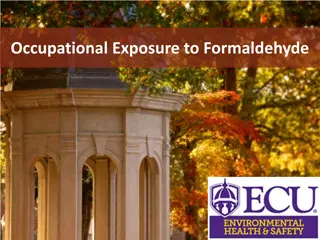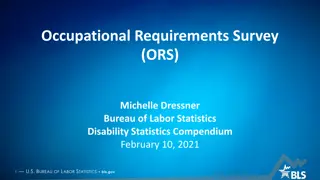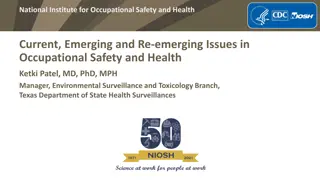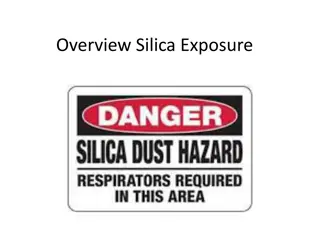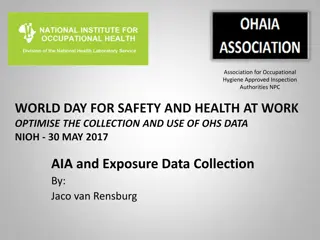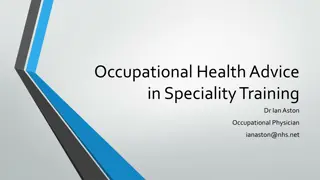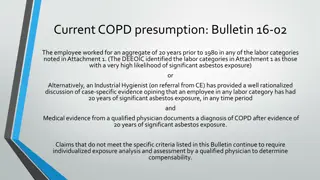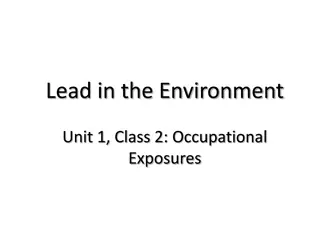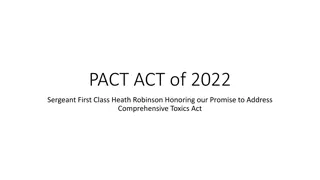Occupational Exposure Guidance Relating to Asbestos
Asbestos-related diseases such as asbestosis, lung cancer, and mesothelioma pose risks to workers, especially those in specific occupations. The EEOICPA Circular No. 15-05 provides guidance on assessing potential asbestos exposure for Department of Energy (DOE) workers post-1986, emphasizing the need for evidence in cases of elevated exposure levels. Any findings of exposure, regardless of frequency, require medical review to determine causation, highlighting the importance of monitoring and addressing occupational risks.
Download Presentation

Please find below an Image/Link to download the presentation.
The content on the website is provided AS IS for your information and personal use only. It may not be sold, licensed, or shared on other websites without obtaining consent from the author. Download presentation by click this link. If you encounter any issues during the download, it is possible that the publisher has removed the file from their server.
E N D
Presentation Transcript
EEOICPA CIRCULAR NO.15- 05 SUBJECT: Occupational Exposure Guidance Relating to Asbestos December 17, 2014
EEOICPA CIRCULAR NO.15- 05 Asbestos-related diseases (ARD) Asbestosis Asbestos-related pleural disease Lung cancer Mesothelioma (chest, abdomen) Cancer of larynx Cancer of ovary COPD
EEOICPA CIRCULAR NO.15- 05 For DOE worker with ARD, post 1986 work: Assume potential exposure to asbestos but at levels below accepted standards, except for 19 occupations on List A, who have potential for greater asbestos exposure between 1986 and 1995 For DOE worker with ARD and who worked at a job on List A between 1986 and 1995, it is accepted that they were potentially exposed to asbestos but likely at low levels.
EEOICPA CIRCULAR NO.15- 05 For CE to accept level of exposure above low level, there must be definitive and compelling evidence to show that post 1986 DOE work had consistent, unprotected contact with asbestos or ACM Evidence includes: IH monitoring, incident reports, documented abatement breaches, testimony or affidavits, or position descriptions.
EEOICPA CIRCULAR NO.15- 05 If evidence is suggestive of exposure above the guidelines, then CE contacts EEOICP IH regarding industrial hygiene referral.
EEOICPA CIRCULAR NO.15- 05 Any findings of exposure, including infrequent, incidental exposure, require review of a physician to opine on the possibility of causation. This is necessary as even minimal exposure to some toxins may have a significant aggravating or contributing relationship to the diagnosed illness.
EEOICPA CIRCULAR NO.15- 05 Summary 1. No presumptions on pre-1986 asbestos exposure 2. Post 1986, assume asbestos exposure was below accepted standard, except for List A workers 3. For List A workers, 1986-1995 work, assume potential asbestos exposure likely at low levels.
EEOICPA CIRCULAR NO.15- 05 Summary 3. For List A workers, 1986-1995 work, assume potential asbestos exposure likely at low levels. 4. To show greater than low level asbestos exposure in post-1986 DOE work , need definitive and compelling evidence to show that had consistent, unprotected contact with asbestos or ACM
EEOICPA CIRCULAR NO.15- 05 Summary 5. If evidence of #4, screening referral to industrial hygienist. 6. Any finding of exposure requires physician review.
EEOICPA CIRCULAR NO.15- 05 Issues 1. No pre-1986 presumptions 2. List A work between 1986 and 1995: likely low exposure is not evidence-based. 3. Designation of List A 1986-1995 work as involving likely low exposure does not facilitate decision-making.
EEOICPA CIRCULAR NO.15- 05 Issues 4. CE has to judge whether submitted evidence meets a vague threshold for IH referral: consistent, unprotected contact with asbestos or ACM 5. Exposure-based CE decision-making is contradicted by stated basis for physician review.
EEOICPA CIRCULAR NO.15- 05 Possible remedies for claims of ARDs 1. Amend List A 2. Presume List A DOE workers who worked prior to the late 1980 s had significant exposure to asbestos exposure, which contributed the to the claimed ARD. 3. For all other claims, have industrial hygienist and/or OM physician review exposure evidence and decide on significance of exposure.
EEOICPA CIRCULAR NO.15- 05 Possible remedies for claims of ARDs 4. Consider including exposure duration and latency minimums in presumptions. 5. Specify terms of review for claimants who do not meet presumptions.
EEOICPA Bulletin No. 13-02 Asbestos and Ovarian Cancer Exposure presumption: 250 days of significant asbestos exposure (worked in a job title in List A), i.e., 1 year prior to 1986, and 20 years latency period from first DOE exposure to asbestos Or diagnosis of asbestosis or mesothelioma
EEOICPA Bulletin No. 13-02 Asbestos and Ovarian Cancer Claims which do not meet exposure presumptions are referred for industrial hygiene review.
EEOICP Procedures Manual, Chapter 2 Assessing asbestosis claims DEEOIC accepts that asbestos was a common toxic substance that existed throughout all DOE facilities. While asbestos did exist at DOE facilities, the nature of an employee s exposure would have varied based on different factors such as the period that the employee worked, the type of work performed, and the location of employment.
Surgeon General Second hand smoke and lung cancer (52 spousal studies, 25 workplace studies) RR= 1.20 Conclusion: Exposure of adults to secondhand smoke causes .lung cancer. 2006 Surgeon General s Report https://www.ncbi.nlm.nih.gov/books/NBK44330/#rpt-smokeexp.ch7.s2
